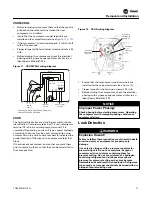
WARNING
Follow EHS Policies!
Failure to follow instructions below could result in
death or serious injury.
•
All Trane personnel must follow the company’s
Environmental, Health and Safety (EHS) policies
when performing work such as hot work, electrical,
fall protection, lockout/tagout, refrigerant handling,
etc. Where local regulations are more stringent than
these policies, those regulations supersede these
policies.
•
Non-Trane personnel should always follow local
regulations.
WARNING
R-410A Refrigerant under Higher Pressure
than R-22!
Failure to use proper equipment or components as
described below, could result in equipment failing and
possibly exploding, which could result in death, serious
injury, or equipment damage.
The units described in this manual use R-410A
refrigerant which operates at higher pressures than R-
22. Use ONLY R-410A rated service equipment or
components with these units. For specific handling
concerns with R- 410A, please contact your local Trane
representative.
WARNING
Explosion Hazard and Deadly Gases!
Failure to follow all proper safe refrigerant handling
practices could result in death or serious injury.
Never solder, braze or weld on refrigerant lines or any
unit components that are above atmospheric pressure
or where refrigerant may be present. Always remove
refrigerant by following the guidelines established by
the EPA Federal Clean Air Act or other state or local
codes as appropriate. After refrigerant removal, use dry
nitrogen to bring system back to atmospheric pressure
before opening system for repairs. Mixtures of
refrigerants and air under pressure may become
combustible in the presence of an ignition source
leading to an explosion. Excessive heat from soldering,
brazing or welding with refrigerant vapors present can
form highly toxic gases and extremely corrosive acids.
WARNING
Explosion Hazard!
Failure to follow these instructions could result in death
or serious injury or equipment or property-only
damage.
Use only dry nitrogen with a pressure regulator for
pressurizing unit. Do not use acetylene, oxygen or
compressed air or mixtures containing them for
pressure testing. Do not use mixtures of a hydrogen
containing refrigerant and air above atmospheric
pressure for pressure testing as they may become
flammable and could result in an explosion. Refrigerant,
when used as a trace gas should only be mixed with dry
nitrogen for pressurizing units.
WARNING
Hazardous Service Procedures!
Failure to follow all precautions in this manual and on
the tags, stickers, and labels could result in death or
serious injury.
Technicians, in order to protect themselves from
potential electrical, mechanical, and chemical hazards,
MUST follow precautions in this manual and on the
tags, stickers, and labels, as well as the following
instructions: Unless specified otherwise, disconnect all
electrical power including remote disconnect and
discharge all energy storing devices such as capacitors
before servicing. Follow proper lockout/tagout
procedures to ensure the power can not be
inadvertently energized.When necessary to work with
live electrical components, have a qualified licensed
electrician or other individual who has been trained in
handling live electrical components perform these
tasks.
WARNING
Hazardous Conditions!
Observe and follow the “Warning” and “Notices” labels
on the compressor. Failure to follow these instructions
could result in death or serious injury or damage to the
equipment.
NOTICE
Use Proper Charging and Crankcase
Heater Operation Procedures!
Failure to utilize proper charging and crankcase heater
procedure will result in compressor failure. Refer to unit
IOM or
and
in this manual for the proper
procedures.
Introduction
COM-SVN01D-EN
3




































